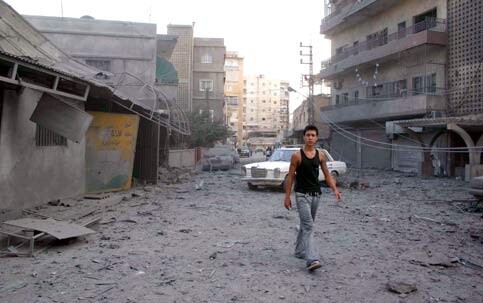IRIN 9 August 2006

A resident walks through the devastation of an Israeli airstrike on a building in central Tyre, 7 August 2006. (Hugh Macleod/IRIN)
TYRE - As explosions from an Israeli bombardment blew open the doors of her apartment and sent her two terrified daughters scrambling into her arms, Fatima Abbas explained why she had moved back home to Tyre in south Lebanon from the relative safety of the mountains near Sidon.
“I wanted to come back from the first day we arrived in Ketermaya,” said the young mother, explaining her decision to leave the mountain town 20km northeast of Sidon, to which she had fled on the first day of the war between Israel and the armed wing of Lebanese political party Hezbollah.
The current conflict started after Hezbollah captured two Israeli soldiers on 12 July. This led to an Israeli military response that has so far killed 1,020 people in Lebanon and forced 915,000 people from their homes, according to the Higher Relief Council - a government body set up specifically to manage relief efforts during this conflict.
Hezbollah has responded by firing rockets into northern Israel and fighting Israel’s ground troops in Lebanon, killing some 39 civilians and more than 60 soldiers, according to the Israeli Defense Forces (IDF).
For people from south Lebanon, which has borne the brunt of Israel’s military offensive, the choices of what to do or where to go are dire. By way of phone calls, media outlets and the dropping of leaflets, the IDF has warned southerners to leave the south altogether.
For those that flee north, some are fortunate to find family and friends they can stay with. Others, such as the Abbas family, must find shelters for the displaced or pay to live in cramped and unhygienic conditions.
“Most other families [fleeing to Ketermaya] were provided with homes, but I ended up having to rent a shared flat with 35 people with no electricity and no running water,” said Abbas.
She chose to return to the port city of Tyre, where aid agencies are trying to deliver a measure of relief to the displaced persons who have gathered in schools and public buildings in and around the port city.
Israel has warned Tyre residents to remain indoors after 10pm and that any moving vehicle on any road south of the Litani River, some 30km north of the Lebanese-Israeli border, would be targeted.
One local activist said he was concerned that not enough had been done to help people living in scattered apartment blocks in and around the city. “There are thousands of people in empty buildings in and around Tyre, and no one is reaching them,” said Assad al-Dor, a social economic officer for the United Nations Development Program (UNDP).
Al-Dor went on to voice particular concern about people remaining in Batoulay and Ain Baal, 8km southeast of Tyre, and in Marake, some 12km east of Tyre, where he said at least 3,000 people remained. “They’re simply staying put because they say they would rather die in their homes than be humiliated elsewhere,” said al-Dor.
Abbas’ husband Mohammed Farhat said he and his family would never leave their home, despite having received a phone call from the IDF telling him to leave the area and demanding to know the location of Hezbollah leader Hassan Nasrallah.
“The Israelis can come into Lebanon but can they remain, or even retreat easily?” asked Farhat, wearing a T-shirt bearing the image of a local Shi’ite religious leader. “We’re ready for anything. This is our land. Are they really going to destroy the country over two soldiers? No matter how much they shell us, they’ll get nothing. And no matter how much we shell them, we’ll gain nothing. We’re just going to have to sit down at the table and talk.”
Related Links
This item comes to you via IRIN, a UN humanitarian news and information service, but may not necessarily reflect the views of the United Nations or its agencies. All IRIN material may be reposted or reprinted free-of-charge; refer to the copyright page for conditions of use. IRIN is a project of the UN Office for the Coordination of Humanitarian Affairs.